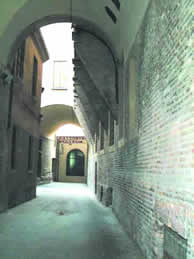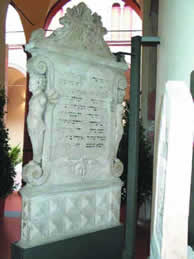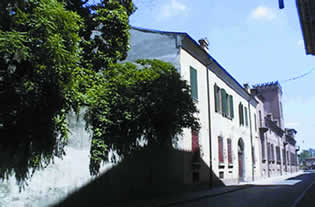Not Only the Garden of
Finzi
Contini
by Paola Rubbi
Traces, accounts and history of Hebraic presence on our land.
The Garden of Finzi Contini is probably the place that first comes to
mind when speaking of Hebraic life in the region. A family, a city, a life, a
tragedy that have become paradigmatic thanks to a best-seller book and to what
is called today a cult movie. However, if we think about it some more , it is possible to easily locate areas of settlements of Hebraic
communities in various cities: ghettos, more or less spread out, well or not so
well preserved, in Ferrara, Bologna, Modena, and Reggio Emilia.
, it is possible to easily locate areas of settlements of Hebraic
communities in various cities: ghettos, more or less spread out, well or not so
well preserved, in Ferrara, Bologna, Modena, and Reggio Emilia.
In reality,
there are many and important Hebraic monuments, very valuable historical and
cultural remnants existing in various areas of Emilia Romagna, from Parma
to Lugo, from Cento to Busseto, from Correggio to Soragna, only to name a
few.
Undoubtedly, Hebraic life in the region - beginning in 1200 until 1400
and 1500 - had developed differently from one area to the other also because of
differences in the historical and social reality into which they integrated. The
presence of these communities, however, often through tragic events and
sometimes rapid changes, always supported by a profound and specific culture,
has left in various places traces and testimonies that are always deeply
connected to the history of the Jewish people and of the villages in which they
lived.
Architecture and topography offer us evocative, unequivocal and
precise souvenirs of Hebraic presence in our communities. But, if it is easy to
recognize in Bologna the ghetto area at the foot of the Two Towers, right in the
medieval historical centre, with a very well preserved urban structure, which is
the base of Via Inferno, it is more difficult to identify Hebraic traces in
smaller communities where they were also present.
Before suggesting  some interesting destinations, it is probably appropriate to recall
that the institution of ghettos was a direct consequence of the papal bull
adopted by Pope Paul IV Carafa in 1555 in which he required that each community
under the jurisdiction of the Church separate Jews from the rest of the
population. The areas intended for such communities had to be surrounded by a
wall with passages barricaded with large doors closed from sunset until dawn.
some interesting destinations, it is probably appropriate to recall
that the institution of ghettos was a direct consequence of the papal bull
adopted by Pope Paul IV Carafa in 1555 in which he required that each community
under the jurisdiction of the Church separate Jews from the rest of the
population. The areas intended for such communities had to be surrounded by a
wall with passages barricaded with large doors closed from sunset until dawn.
In Bologna, the ghetto was established in 1556 and one of the most
flourishing activities that took place there was high-level typography.
In
Ferrara, the Hebraic presence has very ancient origins. The first known writings
date back to 1275, and with the Estensi, during the following centuries, took
place a true Jewish revival of culture and scholars. Corso Giovecca (or
Giudecca) apparently owes its name to Jewish presence, and many streets, from
the area of the Estense Castle, have preserved their urban qualities and the
atmosphere of the ancient days at a time when they were the road network of the
ghetto. The remains of the hinges of one of the five gates, which isolated the
ghetto, are still visible on a wall on Via Mazzini.
Hebraic testimonies are also easily identifiable in Finale Emilia
in the now Via Moranti (it was called, before, Strada della Scola) with its
arches giving access to the ghetto and the old cemetery.
In Modigliana still
today there are Jews on Via Ghetto and there is a group of buildings where was
established the family Moisč da Fano who was granted permission to open a bank
and a shop.
Bertinoro is another centre where, from 1300, a group of Jews,
however small, moved around a loan bank of which the main office can be found on
Via Mainardi. In front of it are various Jewish houses among which the one that
belonged to Ovadia Ben Avraham Y-arč da Bertinoro, scholar and traveller, who
died in the Land of Israel in 1515.
In Olivetto, in Bolognese, a short
distance from the castle, on the wall of an imposing building, there is a
commemorative plaque in terracotta written in Latin, which tells about the date
of its construction, beginning of 1400, by a certain Salomon di Gaglio. The
house today is still called the house of the Jew.
Parma is rich with
testimonies (from the synagogue on Via Cervi to the cemetery) as well as
libraries preserved in the Palatine Library. But, it is in Soragna that are
preserved precious objects from about all the Hebraic communities of the area
and gathered in a museum: books, liturgical objects, documents. About the
temple, it is known for certain that during the second half of 1600 the house of
the Jews was the same as today.